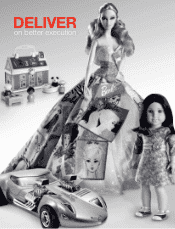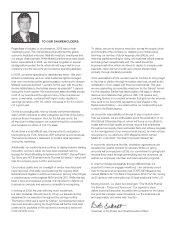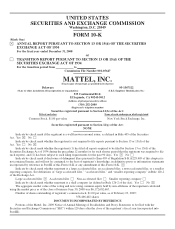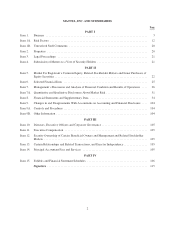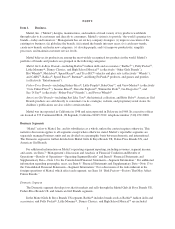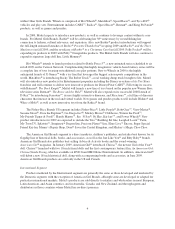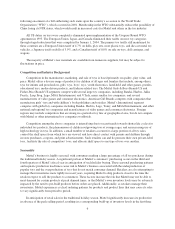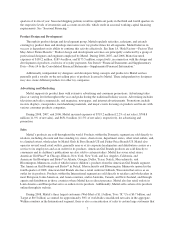Mattel 2008 Annual Report Download - page 10
Download and view the complete annual report
Please find page 10 of the 2008 Mattel annual report below. You can navigate through the pages in the report by either clicking on the pages listed below, or by using the keyword search tool below to find specific information within the annual report.following enactment of a bill authorizing such status upon the country’s accession to the World Trade
Organization (“WTO”), which occurred in 2001. Membership in the WTO substantially reduces the possibility of
China losing its NTR status, which would result in increased costs for Mattel and others in the toy industry.
All US duties on toys were completely eliminated upon implementation of the Uruguay Round WTO
agreement in 1995. The European Union, Japan, and Canada eliminated their tariffs on most toy categories
through staged reductions that were completed by January 1, 2004. The primary toy tariffs still maintained by
these countries are a European Union tariff of 4.7% on dolls, play sets, most plastic toys, and die cast metal toy
vehicles, a Japanese tariff on dolls of 3.9%, and a Canadian tariff of 8.0% on ride on toys, doll carriages, and
wagons.
The majority of Mattel’s raw materials are available from numerous suppliers, but may be subject to
fluctuations in price.
Competition and Industry Background
Competition in the manufacture, marketing, and sale of toys is based primarily on quality, play value, and
price. Mattel offers a diverse range of products for children of all ages and families that include, among others,
toys for infants and preschoolers, girls’ toys, boys’ toys, youth electronics, hand-held and other games, puzzles,
educational toys, media-driven products, and fashion-related toys. The Mattel Girls & Boys Brands US and
Fisher-Price Brands US segments compete with several large toy companies, including Bandai, Hasbro, Jakks
Pacific, Leap Frog, Lego, MGA Entertainment, and VTech, many smaller toy companies, and several
manufacturers of video games and consumer electronics. American Girl Brands competes with companies that
manufacture girls’ toys and with children’s book publishers and retailers. Mattel’s International segment
competes with global toy companies including Bandai, Hasbro, Lego, Tomy, and MGA Entertainment, and other
national and regional toy companies and manufacturers of video games and consumer electronics. Foreign
regions may include competitors that are strong in a particular toy line or geographical area, but do not compete
with Mattel or other international toy companies worldwide.
Competition among the above companies is intensifying due to recent trends towards shorter life cycles for
individual toy products, the phenomenon of children outgrowing toys at younger ages, and an increasing use of
high technology in toys. In addition, a small number of retailers account for a large portion of all toy sales,
control the shelf space from which toys are viewed, and have direct contact with parents and children through
in-store purchases, coupons, and print advertisements. Such retailers can and do promote their own private-label
toys, facilitate the sale of competitors’ toys, and allocate shelf space to one type of toys over another.
Seasonality
Mattel’s business is highly seasonal, with consumers making a large percentage of all toy purchases during
the traditional holiday season. A significant portion of Mattel’s customers’ purchasing occurs in the third and
fourth quarters of Mattel’s fiscal year in anticipation of such holiday buying. These seasonal purchasing patterns
and requisite production lead times cause risk to Mattel’s business associated with the underproduction of
popular toys and the overproduction of toys that do not match consumer demand. Retailers are also attempting to
manage their inventories more tightly in recent years, requiring Mattel to ship products closer to the time the
retailers expect to sell the products to consumers. These factors increase the risk that Mattel may not be able to
meet demand for certain products at peak demand times, or that Mattel’s own inventory levels may be adversely
impacted by the need to pre-build products before orders are placed. Additionally, as retailers manage their
inventories, Mattel experiences cyclical ordering patterns for products and product lines that may cause its sales
to vary significantly from period to period.
In anticipation of retail sales in the traditional holiday season, Mattel significantly increases its production
in advance of the peak selling period, resulting in a corresponding build-up of inventory levels in the first three
6


